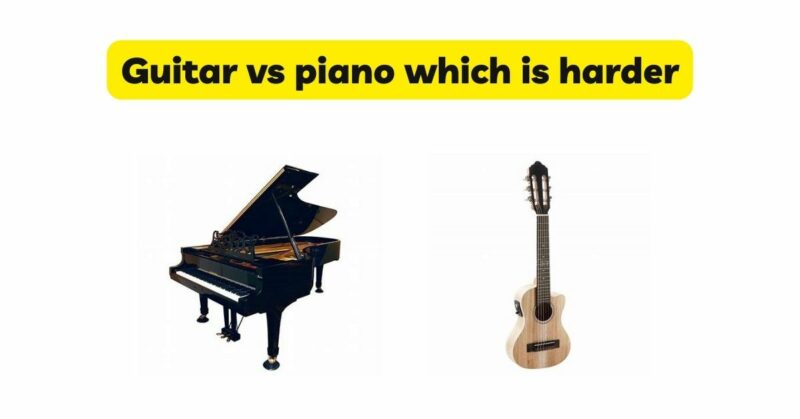When it comes to learning a musical instrument, the guitar and the piano are two popular choices that often ignite debates on which one is harder to master. Both instruments require dedication, practice, and a deep understanding of music theory. In this article, we will delve into the complexities and challenges of learning the guitar and the piano, aiming to provide insights into the unique difficulties each instrument presents.
I. The Guitar: Unraveling the Fretboard’s Mysteries
- Technique and Physicality: Learning to play the guitar demands the development of specific techniques, including finger placement, strumming, and picking patterns. The fretboard, with its array of notes and chord shapes, can be initially overwhelming, requiring diligent practice to build muscle memory and finger dexterity. The physicality involved in playing the guitar, such as fretting strings and coordinating hand movements, can pose challenges for beginners.
- Coordination and Timing: The guitar’s six strings and the need to simultaneously play melody, chords, and rhythm can present coordination challenges. Coordinating the left and right hands to produce harmonious sounds requires practice and precision. Additionally, mastering rhythm and timing while strumming or fingerpicking can be demanding, as it involves maintaining a steady tempo and accurately synchronizing with other musicians in an ensemble setting.
- Music Theory and Transposition: Understanding music theory is crucial for guitarists, as it aids in constructing chords, transposing songs, and improvising solos. Learning to read guitar sheet music and deciphering chord diagrams can be daunting tasks, especially for beginners with limited musical background. Moreover, guitarists often need to transpose songs to different keys, which requires knowledge of scales, intervals, and chord progressions.
II. The Piano: Taming the Keyboard’s Complexity
- Hand Independence: One of the significant challenges in piano playing is developing hand independence. The ability to play different melodies and harmonies simultaneously with each hand demands concentration, coordination, and practice. Pianists must train their hands to move independently, playing different rhythms, dynamics, and note patterns. This skill takes time to develop and requires consistent practice to achieve fluency.
- Reading Sheet Music: Piano players are expected to read sheet music in two clefs simultaneously, the treble and bass clefs. This dual reading skill can be overwhelming for beginners, as it involves deciphering complex musical notation and quickly translating it into precise hand movements on the keyboard. The ability to sight-read proficiently is an ongoing challenge that requires dedication and practice.
- Dynamic Expression and Interpretation: The piano’s wide range of dynamics, from soft and delicate to powerful and thunderous, adds another layer of complexity. Pianists must learn to control touch, tone, and dynamics to express the intended emotions and convey the composer’s intentions accurately. This nuanced expression and interpretation require sensitivity, musicality, and a deep understanding of the piece being performed.
III. Individual Factors: Perceptions of Difficulty
- Musical Background: An individual’s previous musical experience can influence their perception of difficulty when learning either the guitar or the piano. Those with prior knowledge of music theory or experience with stringed instruments may find the guitar more approachable, while individuals with a background in keyboard instruments may feel more at ease with the piano. However, these factors are subjective and can vary from person to person.
- Personal Learning Style: Different individuals have varying learning styles and preferences. Some may thrive on the tactile nature of the guitar, while others might find solace in the structured layout of the piano keyboard. Personal inclinations toward certain playing techniques, musical genres, or the type of music they wish to create can also affect perceived difficulty. It is essential to align personal preferences and learning style with the instrument of choice.
- Commitment and Practice: Regardless of the instrument chosen, commitment and practice are fundamental to progress and mastery. Regular and focused practice sessions, coupled with a passion for the instrument, play a vital role in overcoming challenges and pushing boundaries. Dedication, perseverance, and patience are keys to tackling the difficulties associated with learning either the guitar or the piano.
Conclusion:
Determining whether the guitar or the piano is harder to learn ultimately depends on the individual’s perspective, prior experience, and personal inclination. Both instruments offer unique challenges and rewards. The guitar demands finger dexterity, coordination, and an understanding of music theory, while the piano requires hand independence, sight-reading skills, and nuanced expression.
Instead of fixating on which instrument is more difficult, aspiring musicians should embrace the journey of learning, recognizing that challenges are inherent in any worthwhile pursuit. The process of mastering an instrument is a personal and fulfilling endeavor, offering not only technical skill but also a profound connection to music and self-expression.
Ultimately, the choice between the guitar and the piano should be guided by one’s musical aspirations, personal inclinations, and the genres of music that resonate with them. Remember, the challenges faced while learning an instrument can be overcome with dedication, practice, and a genuine love for the art of making music.


